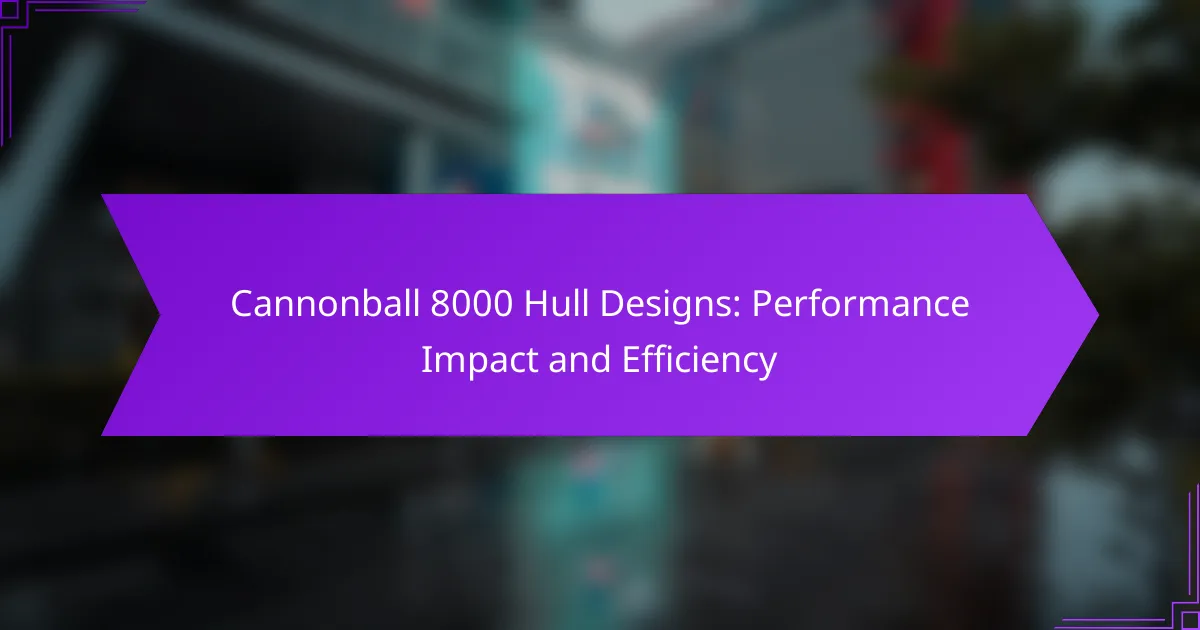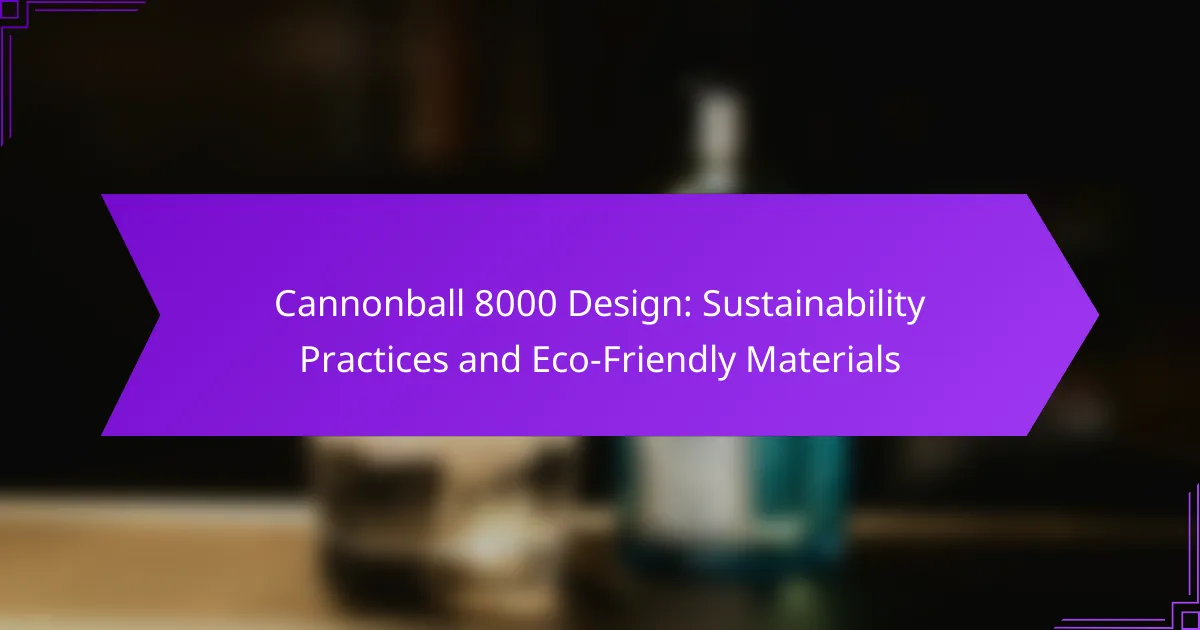The Cannonball 8000 hull designs are engineered to optimize performance, enhancing speed, maneuverability, and fuel efficiency while maintaining stability across various water conditions. Key features, including advanced hydrodynamic shapes and specialized materials, play a vital role in minimizing drag and maximizing efficiency, making these vessels ideal for high-speed marine applications.
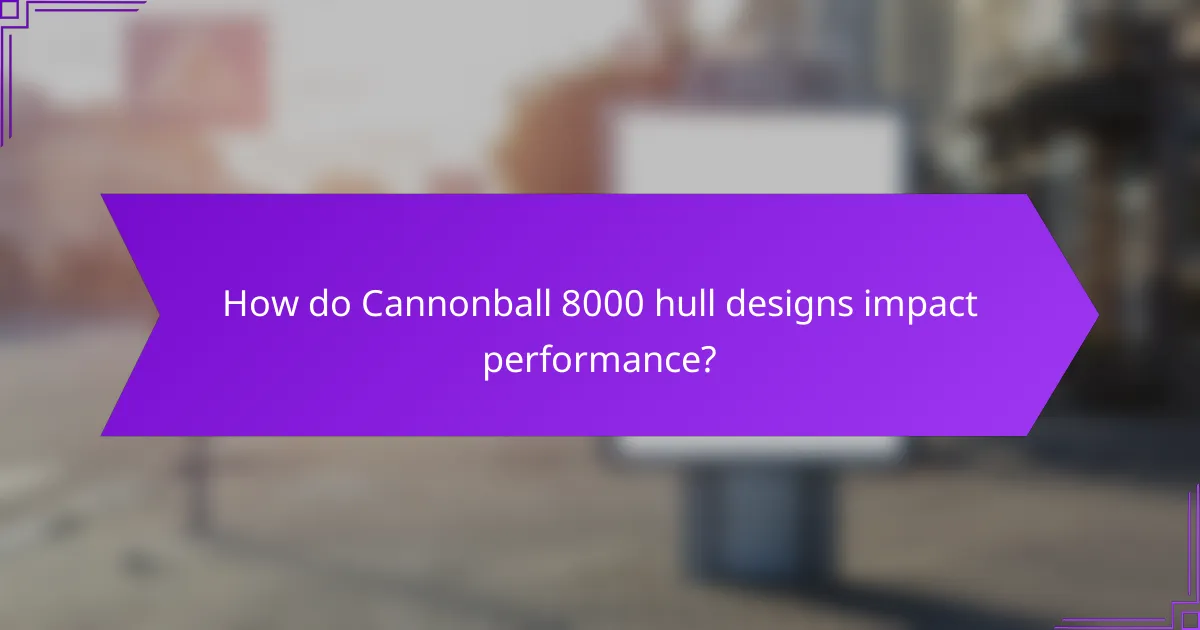
How do Cannonball 8000 hull designs impact performance?
Cannonball 8000 hull designs significantly influence performance by enhancing speed, maneuverability, and fuel efficiency while ensuring stability in diverse water conditions. The design features, such as shape and materials, play a crucial role in determining how well the vessel performs in various scenarios.
Enhanced speed and maneuverability
The hull design of the Cannonball 8000 is optimized for speed and agility, allowing it to cut through water with minimal resistance. A streamlined shape reduces drag, enabling faster acceleration and better handling during sharp turns.
For instance, a well-designed hull can achieve speeds exceeding 30 knots, depending on engine power and load. This agility is particularly beneficial in competitive settings, where quick maneuvers can make a significant difference in race outcomes.
Improved fuel efficiency
Efficient hull designs contribute to improved fuel economy by minimizing drag and maximizing propulsion. A well-optimized hull can lead to fuel savings of up to 20-30%, depending on operating conditions and speed.
When selecting a Cannonball 8000, consider the hull shape and materials used, as these factors directly affect fuel consumption. Using lightweight materials can further enhance efficiency, allowing for longer trips without frequent refueling.
Stability in various water conditions
The Cannonball 8000 hull is engineered to maintain stability across a range of water conditions, from calm lakes to choppy seas. A deeper V-shape can provide better stability and comfort, reducing the impact of waves on the vessel.
In practice, this means that operators can confidently navigate through rough waters without excessive pitching or rolling. Ensuring that the hull design is suitable for the intended use will enhance safety and performance during excursions.

What are the key features of Cannonball 8000 hull designs?
The Cannonball 8000 hull designs are characterized by their advanced hydrodynamic shapes, specialized material compositions, and optimized weight distributions. These features significantly enhance performance and efficiency, making them suitable for high-speed marine applications.
Hydrodynamic shape
The hydrodynamic shape of the Cannonball 8000 hull is engineered to minimize water resistance and maximize speed. A streamlined profile reduces drag, allowing the vessel to glide more efficiently through water. This design is crucial for achieving higher velocities while maintaining stability.
Key aspects of the hydrodynamic shape include a sharp bow for cutting through waves and a tapered stern that helps in smooth water exit. These elements work together to improve overall maneuverability and fuel efficiency, which can lead to reduced operational costs over time.
Material composition
Cannonball 8000 hulls are typically constructed from advanced composite materials that offer a balance of strength and lightweight properties. Common materials include fiberglass and carbon fiber, which provide durability while reducing overall weight. This composition is essential for enhancing speed and fuel efficiency.
Using high-quality materials also contributes to the vessel’s resistance to corrosion and environmental wear, which is particularly important for long-term performance in various marine conditions. Choosing the right material can significantly impact maintenance costs and lifespan.
Weight distribution
Effective weight distribution in Cannonball 8000 hull designs is critical for stability and performance. Properly balanced weight ensures that the vessel remains upright and responsive during high-speed maneuvers. This balance is achieved by strategically placing heavy components, such as engines and fuel tanks, within the hull.
Additionally, optimizing weight distribution can improve fuel efficiency by reducing the energy required to maintain speed. Operators should regularly assess weight placement and make adjustments as necessary to maintain optimal performance and handling characteristics.
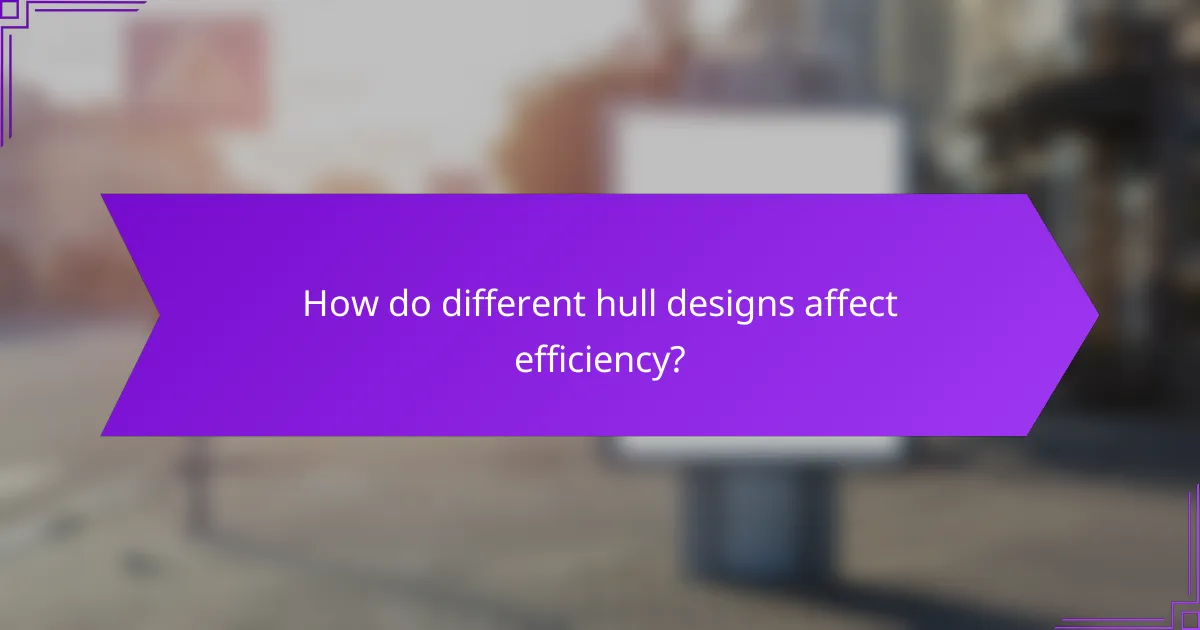
How do different hull designs affect efficiency?
Different hull designs significantly impact a vessel’s efficiency by influencing factors such as drag, stability, and speed. The shape, length, and width of the hull can optimize performance for specific conditions, making it crucial to choose the right design for the intended use.
Comparative analysis of hull shapes
Hull shapes vary widely, with each design offering unique advantages. For example, a deep-V hull is known for its ability to cut through waves, providing a smoother ride in choppy waters, while a flat-bottom hull offers stability and ease of access in shallow areas. Understanding these differences helps in selecting the right hull for specific operational needs.
When comparing hull shapes, consider the trade-offs between speed and stability. A round-bottom hull may provide better speed but less stability, while a multi-chine hull can offer a balance of both. Evaluating the primary use of the vessel will guide the choice of hull shape.
Impact of hull length on drag
The length of a hull plays a critical role in determining drag, with longer hulls generally experiencing less resistance in the water. This reduced drag can lead to improved fuel efficiency and higher speeds, making longer hulls preferable for racing and long-distance travel.
However, longer hulls can also be more challenging to maneuver in tight spaces, which may not be ideal for all applications. A practical approach is to assess the primary operating environment—longer hulls work well in open waters, while shorter hulls are better suited for coastal or inland navigation.
Role of hull width in stability
Hull width is a key factor in a vessel’s stability, with wider hulls providing greater resistance to tipping. This is particularly important for vessels that carry heavy loads or operate in rough conditions, as a wider hull can enhance safety and performance.
On the other hand, a narrower hull can improve speed and agility but may compromise stability. When selecting a hull width, consider the intended use and conditions; for example, fishing vessels may benefit from wider designs for stability, while racing boats may prioritize narrower hulls for speed. Aim for a balance that suits your specific operational requirements.
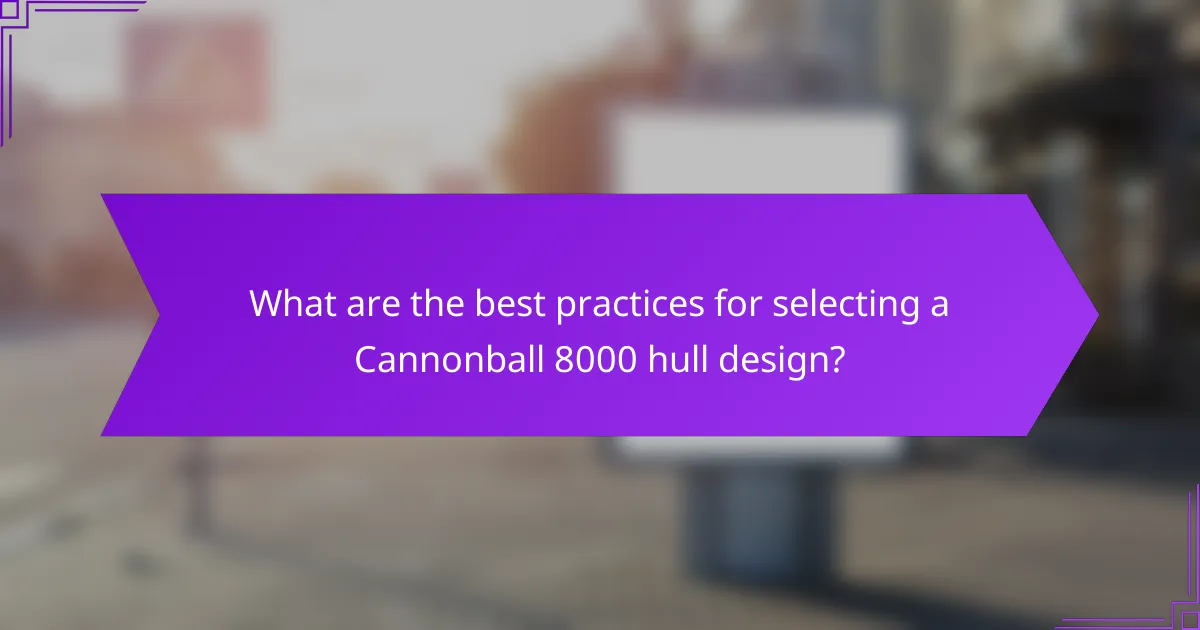
What are the best practices for selecting a Cannonball 8000 hull design?
To select the best Cannonball 8000 hull design, consider your intended use, performance metrics, and expert advice. These factors will help you choose a design that maximizes efficiency and meets your specific needs.
Assessing intended use and conditions
Begin by identifying the primary purpose of your Cannonball 8000. Whether for recreational use, racing, or commercial applications, the hull design should align with your activities. For instance, a racing hull may prioritize speed and agility, while a commercial hull might focus on stability and load capacity.
Additionally, evaluate the water conditions where you will operate. Rough seas may require a hull with a deeper V-shape for better handling, while calm waters could allow for flatter designs that enhance speed.
Evaluating performance metrics
Performance metrics such as speed, fuel efficiency, and maneuverability are crucial when selecting a hull design. Look for designs that offer a balance between speed and stability, as extreme designs may compromise one for the other.
Consider conducting tests or reviewing performance data from similar hulls. Metrics like fuel consumption rates in various conditions can provide insights into long-term operational costs and efficiency.
Consulting with marine architects
Engaging with marine architects can significantly enhance your selection process. These professionals can provide tailored advice based on your specific needs and the latest design innovations. They can also help you navigate regulatory requirements that may affect your hull design.
When consulting, be prepared to discuss your intended use, performance expectations, and budget. This information will enable architects to recommend designs that not only meet your requirements but also optimize performance and safety.

What are the costs associated with Cannonball 8000 hull designs?
The costs associated with Cannonball 8000 hull designs can vary significantly based on design complexity, materials used, and specific performance features. Understanding these costs is crucial for making informed decisions when selecting a hull design that meets both performance and budgetary needs.
Price ranges for different designs
The price of Cannonball 8000 hull designs typically ranges from several thousand to tens of thousands of USD. Basic designs may start around 5,000 USD, while advanced models with specialized features can exceed 30,000 USD. Custom designs tailored for specific performance criteria may command even higher prices.
Factors influencing hull design costs
Several factors influence the costs of hull designs, including the choice of materials, the complexity of the design, and the level of customization required. For instance, using lightweight composite materials can increase initial costs but may enhance performance and fuel efficiency in the long run.
Additionally, the design process itself can vary in cost depending on the expertise of the designer and the technology used for modeling and testing. Designs that require advanced hydrodynamic analysis or simulation will generally incur higher fees.
Long-term maintenance expenses
Long-term maintenance expenses for Cannonball 8000 hulls can also impact overall costs. Regular upkeep, including inspections and repairs, is essential to maintain performance and safety. Owners should budget for routine maintenance, which can range from hundreds to thousands of USD annually, depending on usage and environmental conditions.
Moreover, specific hull materials may require different maintenance approaches. For example, fiberglass hulls might need periodic refinishing, while aluminum hulls may require anti-corrosion treatments, influencing overall long-term costs.

What are the emerging trends in hull design technology?
Emerging trends in hull design technology focus on enhancing performance and efficiency through innovative materials and design techniques. These advancements aim to improve speed, fuel efficiency, and overall vessel stability while reducing environmental impact.
Use of advanced materials
Advanced materials, such as carbon fiber and lightweight composites, are increasingly being used in hull designs to enhance performance. These materials offer a high strength-to-weight ratio, allowing for faster speeds and better fuel efficiency compared to traditional materials like fiberglass or aluminum.
When selecting materials, consider factors such as durability, cost, and maintenance. While advanced materials can be more expensive upfront, their long-term benefits, including reduced fuel costs and lower maintenance needs, often justify the investment.
For example, vessels constructed with carbon fiber can achieve significant weight savings, leading to improved acceleration and maneuverability. However, it is essential to ensure that the manufacturing process adheres to industry standards to maintain structural integrity and safety.
